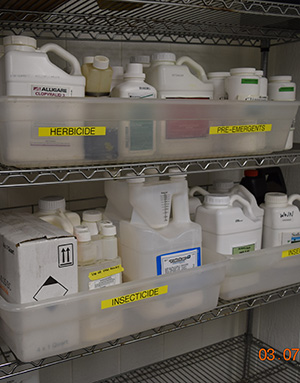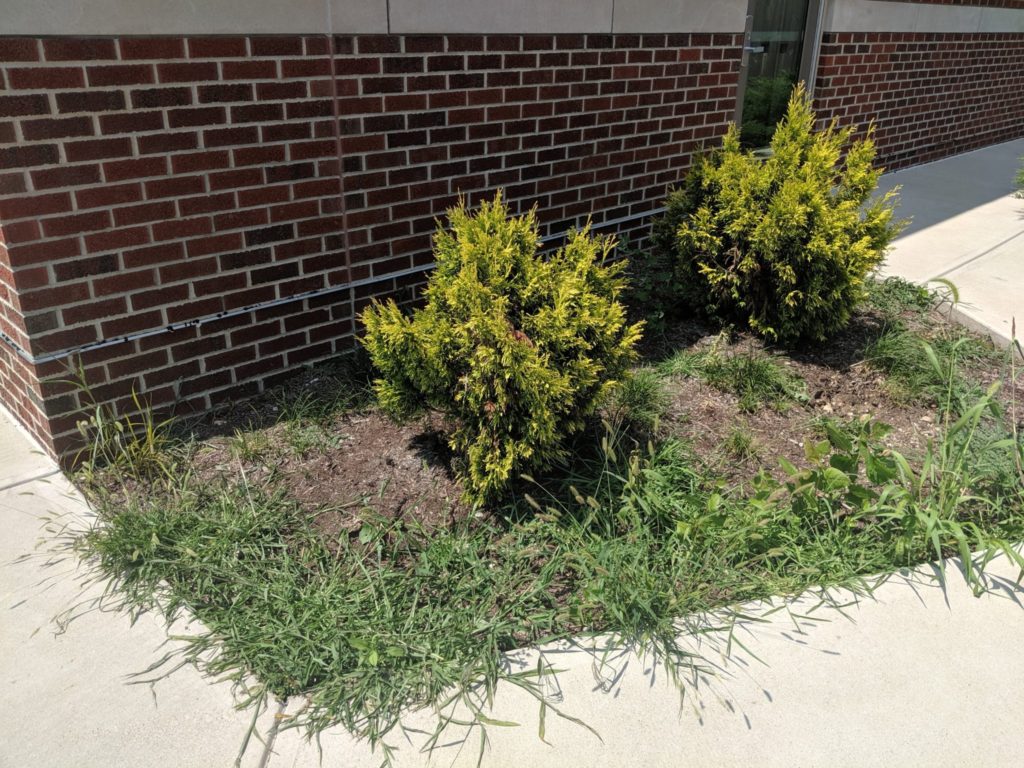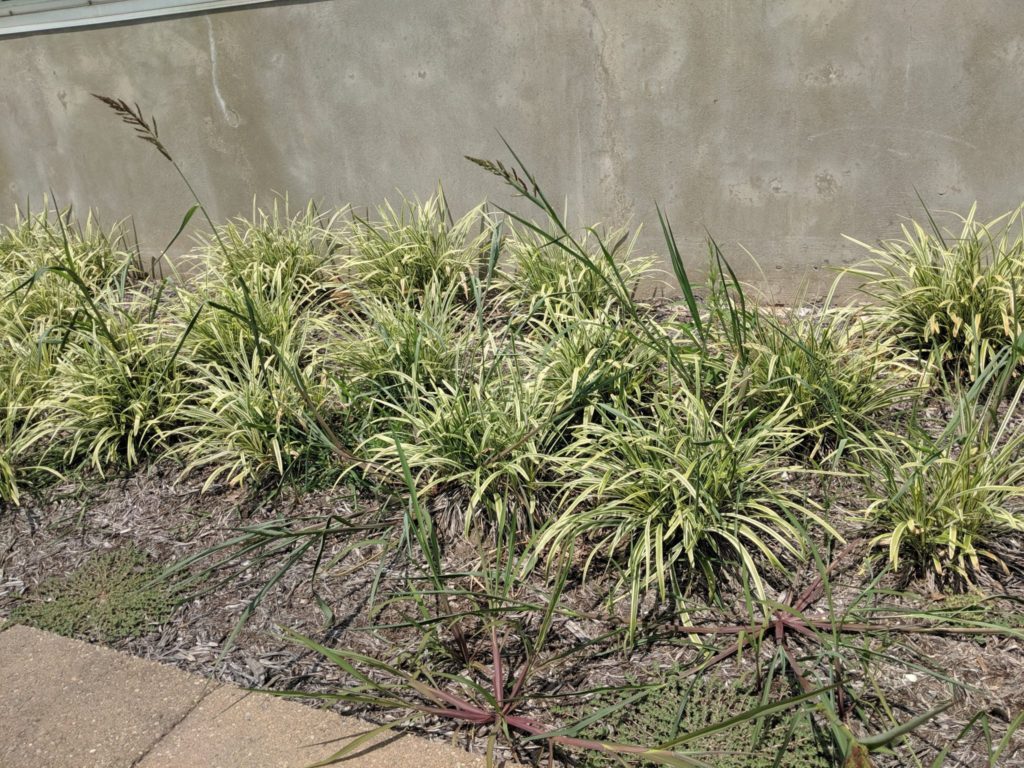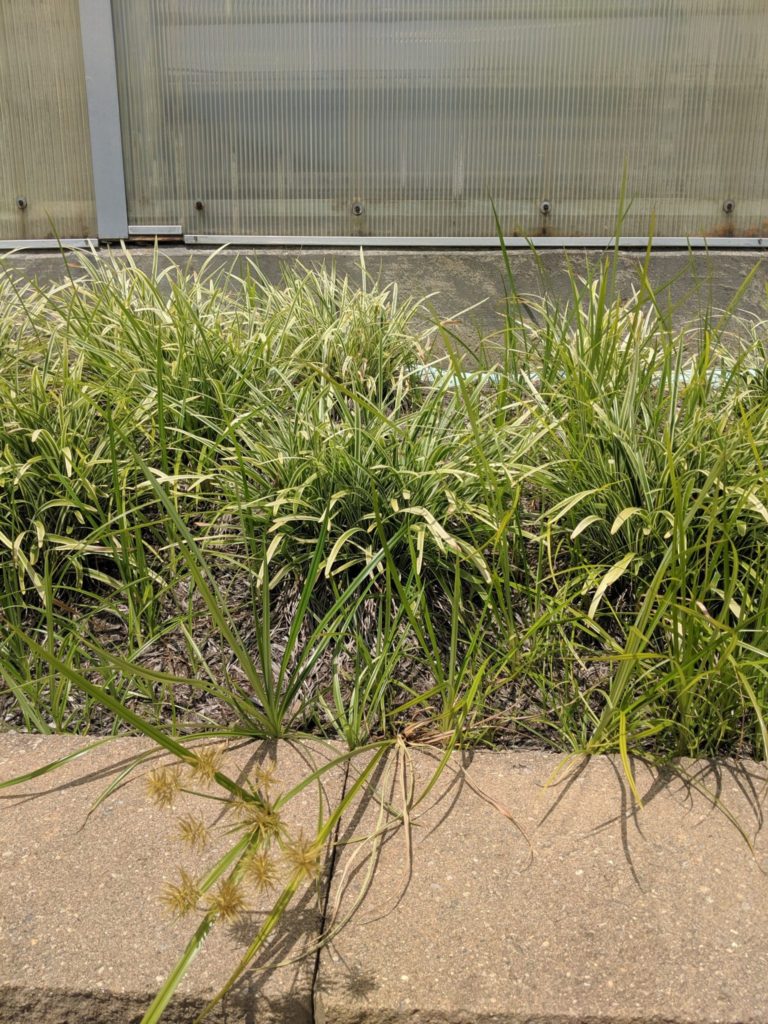What is your go-to postemergence herbicide? If you answered Roundup (glyphosate is the active ingredient in Roundup), you would be in the majority for landscape and nursery professionals. Though glyphosate works very well on most weed species, there are times when other products may be more effective or offer a less phtytotoxic (damage to ornamental plants) alternative (Fig.1). We should also keep in the back of our minds to continue rotating herbicides to prevent herbicide resistant weeds.
- Utilizing several different modes of action in the nursery and landscape can aide in reducing resistant weeds, as well as being more effective on certain weed species.
Roundup has been a household name for over 20 years. It’s most likely the only herbicide that the general public can name. For several years, the most widely used herbicide in the world has been glyphosate (many trade names). There is a reason for the popularity of this herbicide. Some of the positive attributes include non-selective/broad spectrum (kills many types of plants), systemic activity (travels in the vascular system, both xylem and phloem), low mammalian toxicity (relatively safe for humans), limited soil activity, non-volatile, low environmental impact, and the efficacy of the product (how well it kills weeds). With these attributes, it’s not hard to wonder why this product has become a mainstay in the industry.
National media outlets are reporting that there are growing concerns regarding the potential link between glyphosate-containing products and increased risk of cancer. Jury verdicts in California have been covered in great detail by the media, thus elevating the dialogue of the cancer risk with consumers. Purdue Weed Scientists are trained and tasked with studying weed biology, weed competition, various methods of controlling weeds with herbicide and non-chemical tools, and herbicide resistance in weeds. They are also responsible for developing weed control best management plans for a number of crops grown in Indiana and the Midwest. They are not trained to be cancer scientists and thus do not conduct research on the potential risk of cancer. We rely on toxicologists to conduct the appropriate research regarding the toxicology of any pesticide to mammals and amphibians and use their expertise to develop recommendations on the risks associated with various pesticides. To that end, toxicologists affiliated with the National Cancer Institute conducted a review of the literature and found no link between glyphosate and increased risk of cancer. This is the most recent and most prestigious research paper available on the topic. The journal article can be found here: https://academic.oup.com/jnci/article/110/5/509/4590280. A scientific organization wrote an article about this subject in March that discusses the glyphosate-cancer topic in much detail: https://geneticliteracyproject.org/2019/03/26/infographic-global-regulatory-and-health-research-agencies-on-whether-glyphosate-causes-cancer/?mc_cid=41a15fec7f&mc_eid=3dd2ec99f7.
With that in mind, what is going to be your answer when your client request that you stop using glyphosate on their property? Do you have a backup plan? These questions are the reality going forward and some landscape companies are having to devise a new plan that doesn’t use glyphosate on some properties.
Before discussing alternatives to glyphosate, always remember to utilize preemergence herbicides (fall and spring) as your primary method of weed control in nurseries and landscapes. Relying on preemergence herbicides will reduce labor, reduce the chances of phytotoxicity to ornamentals, and reduce total herbicide usage. Postemergence herbicides should be relied upon only when necessary to control weeds that have escaped your preemergence program.
Considering alternatives to glyphosate will require a knowledge of what ornamental plants are on the property, as well as what are the dominant weeds. There is no herbicide that will completely ‘replace’ glyphosate due to the attributes mentioned above. Careful planning by developing a property-wide herbicide plan will assist in determining the optimum solution for reducing the use of glyphosate.
When you are trying to control grassy weeds in ornamentals, there are several options that are very safe on most ornamental plants. The grass specific herbicides, such as fluazifop (Fusilade/Ornamec), clethodim (Select, Envoy), sethoxydim (Poast, Vantage, Grass Getter), and fenoxaprop (Acclaim), can control many grass weeds effectively with little phytotoxicity to most ornamental plantings (Fig.2). These herbicides will only kill grass, so they can be sprayed over the top of many broadleaf ornamentals, as well as plants such as liriope and iris, since these are not grasses (Fig.3). Always check the label to ensure the ornamentals are labelled for over the top or directed sprays. More information about controlling grasses in non-grassy ornamental plants can be found here: https://www.purduelandscapereport.org//article/killing-grasses-in-grasses-how-to-control-grasses-in-non-grassy-ornamental-plants/
- Figure 2. Grass specific herbicides can be utilized over the top on many ornamental plantings in nurseries and landscape to reduce the chance of phytotoxicity on ornamentals.
Contact herbicides are an option and are most effective on annual weeds, especially while small. Since contact herbicides are not translocated throughout the plant, coverage of the weed needs to be sufficient enough to kill. Most large or mature plants tend to outgrow contact herbicide applications. There are some contact herbicides labelled in nurseries and landscape, including Scythe (pelargonic acid), Reward (diquat), and Finale (glufosinate). These products are broad-spectrum, so damage can occur if applied on ornamental plantings. Basagran (sodium salt of bentazon) is a contact that is effective on nutsedge, as well as many broadleaf weeds.
- Figure 3. Grassy weeds can be controlled with grass specific herbicides in liriope.
There is some confusion in the industry that glufosinate (Finale and other trade names) is a ‘replacement’ for glyphosate. Though their names are very similar, they are very different herbicides. As mentioned above, glyphosate is translocated throughout the plant, but glufosinate is a contact herbicide that does not translocate. Though glufosinate could be a replacement for glyphosate in some instances (i.e. small annual weeds), just remember that it will not have the same efficacy as a translocated herbicide on larger or more mature weeds.
Being that glyphosate is a translocated postemergence herbicide that is non-selective, there are a few ‘true’ alternative herbicides that can be used as a substitute. This is where the knowledge of your ornamental plants and types of weeds are very important. Some alternative postemergence herbicides that translocate include, Lontrel (clopyralid) Dismiss (sulfentrazone) and Sedgehammer (halosulfuron-methyl). These products each control hard to control weeds, such as thistle (Lontrel) and nutsedge (Sedgehammer) (Fig.4). These products have some over-the-top use of certain ornamental plantings, but can cause severe damage on certain ornamental plants. The label must be followed carefully when using these products around ornamental plantings due to the potential of severe phytotoxicity or death.
- Figure 4. Some weed species, such as nutsedge, are better controlled with herbicides other than glyphosate.
Glyphosate is a product that is effective in many applications for your weed program, but there are alternatives. As described previously, no singular herbicide will totally replace glyphosate due to many positive attributes. Considering incorporating some of these alternatives will aide in the reduction of resistant weed populations, can be safer around ornamentals, more effective on some weed species, and make your clients more comfortable in having another option available.
To review herbicide modes of action, visit: https://www.extension.purdue.edu/extmedia/WS/WS-23-W.html
There are 82 products available on CDMS containing glyphosate, with almost 1,400 total herbicide labels, that can be found at http://www.cdms.net/Label-Database/Advanced-Search#Result-products.
Remember to always check labels prior to making any herbicide application.
Reference in this publication to any specific commercial product, process, or service, or the use of any trade, firm, or corporation name is for general informational purposes only and does not constitute an endorsement, recommendation, or certification of any kind by Purdue University. Individuals using such products assume responsibility for their use in accordance with current directions of the manufacturer. Always refer to the label prior to making any pesticide application.



